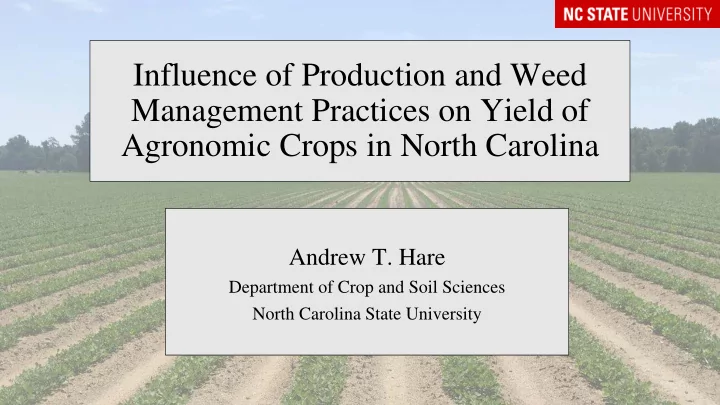

Influence of Production and Weed Management Practices on Yield of Agronomic Crops in North Carolina Andrew T. Hare Department of Crop and Soil Sciences North Carolina State University
Introduction • A limited number of short-term studies have been conducted with major agronomic crops all in the same experiment • A limited number of published articles of non-traditional, double- cropping systems in North Carolina exist • A limited number of studies have been conducted to compare the impacts of management in one season on weed emergence during the following season • Most agronomic research often ends with yield and quality assessments
Chapters I. Potential for Agronomic Crops in a Double Cropping System with Wheat ( Triticum aestivum L.) in North Carolina II. Influence of Timing and Degree of Weed Management on Crop Yield and Contribution to Weed Emergence the Following Year III. Impact of Weed Management on Peanut Yield and Weed Populations the Following Year
Potential for Agronomic Crops in a Double Cropping System with Wheat ( Triticum aestivum L.) in North Carolina
Introduction • Planting Dates and Double-cropping (DC) systems 35% of NC soybean acres were double-cropped in 2018 (USDA- NASS) Corn yield was 40% less when DC compared to when planted between 9 April and 12 May in the coastal plains (Lewis and Phillips, 1976) DC soybean yields have been noted to be 0 to 55% lower than full-season soybean (Beatty and Eldridge, 1980; Caviness and Thomas, 1979) DC cotton produced 65% lower lint yield than when planted in recommended window (Smith and Varvil, 1982) DC peanut can be successful in Georgia (Moss et al. 2014)
Introduction • Planting Dates and Double-cropping (DC) systems continued Peanut planted in May yielded greater than peanut planted in June (Carley et al., 2008) When planted in June following barley, DC corn generated greater net returns than DC grain sorghum and soybean in eastern Virginia (Camper et al., 1972) DC soybean generated greater net returns than DC grain sorghum in Southeastern Virginia (Thomason et al., 2017) In Mississippi, DC soybean generated greater net returns than DC grain sorghum (Sanford et al., 1973) Proper maturity group/hybrid selection for planting dates
Introduction • Relay-intercropping (RI) Complications in early season weed and insect management Reduced wheat yield by 21% when RI with cotton (Foote et al., 2014) Cotton lint yield was similar for monocrop and RI systems but there was variability in comparing net returns of RI cotton, monocropped cotton, and double-cropped soybean (Foote et al., 2014) Double-cropped peanut with wheat generated greater net returns than RI peanut and wheat in Georgia (Moss et al., 2014)
Objectives • To determine if summer crop yield from June plantings is similar to yield of summer crops planted during typical planting window • To determine estimated economic returns of summer crops planted during the typical planting window and compare them to estimated economic returns of summer crops double-cropped with wheat • Determine feasibility of double cropping a summer crop other than wheat and soybean in the five pricing structures used
Materials and Methods • Crops were planted into desiccated or harvested wheat stubble following strip-tillage • Three planting dates were used for each crop, two being in the typical planting window and one mid-June following wheat harvest Corn: mid-April, mid-May, mid-June Cotton Grain sorghum early May, late May, mid-June Peanut Soybean
Materials and Methods • Lewiston-Woodville 2013-2017 (Goldsboro sandy loam and Norfolk sandy loam) • Experimental design: split-plot with summer crop serving as the whole plot unit and planting date serving as the sub-plot unit • Experimental units were 4 rows (91-cm spacing) by 18 m • Within years and crops, same cultivar was planted across all planting dates • Management of all crops was based on North Carolina Extension Service recommendations • Each planting date received the same degree of management
Materials and Methods • Data analysis Yield determined at optimum maturity Yield of each crop was subjected to ANOVA using PROC GLIMMIX with means separated using Fisher’s Protected LSD at p < 0.05 Analyses with year as both fixed and random effects
Materials and Methods • Data analysis Estimated economic returns Five different pricing structure combinations based off of the ten-year average and ten-year high ✔ Ten-year average summer crop and average wheat price ✔ Ten-year high summer crop and high wheat price ✔ Ten-year high summer crop and high wheat price versus ten-year average soybean and high wheat price • Ten-year average summer crop and ten-year high wheat price • Ten-year high summer crop and ten-year average wheat price Estimated economic returns were subjected to ANOVA using GLIMMIX and DUNNETT’s Procedures with means separated using Fisher’s Protected LSD at p < 0.05
Materials and Methods Crop Average Price High Price Base Cost ________________ $ / kg _______________ $ / ha Corn 0.21 ($5.33/bu) 0.32 ($8.13/bu) 1,019 ($413/ac) Cotton lint 1.60 ($0.72/lb) 2.33 ($1.05/lb) 1,493 ($605/ac) Cottonseed 0.20 ($0.09/lb) 0.28 ($0.13/lb) - Grain sorghum 0.17 ($3.86/bu) 0.27 ($6.13/bu) 713 ($289/ac) Peanut 0.58 ($522/ton) 1.02 ($918/ton) 1,719 ($696/ac) Soybean 0.42 ($11.43/bu) 0.62 ($16.88/bu) 771 ($312/ac) Wheat 0.21 ($5.72/bu) 0.33 ($8.99/bu) 519 ($210/ac) *Prices are from 10 year USDA-NASS data (2008-2017)
Recommend
More recommend